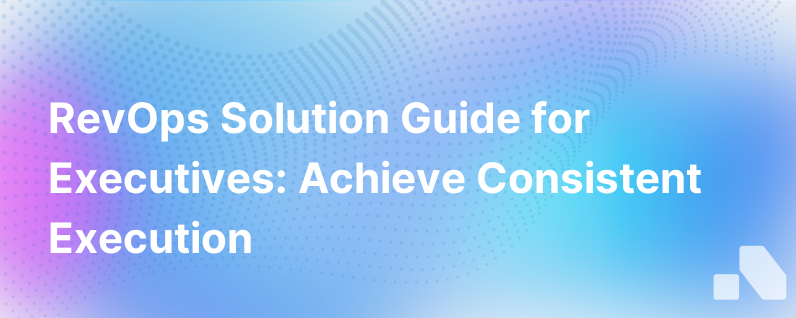
In the high-stakes world of B2B sales, a strategic and streamlined approach to revenue operations (RevOps) is no longer optional—it's a linchpin of competitive advantage. Businesses across the globe are tuning into the immense potential of RevOps to align their sales, marketing, and customer success efforts under one umbrella, orchestrating seamless operations to drive higher revenue growth.
However, with an abundance of RevOps tools and platforms on offer, selecting the right solution can challenge even the most seasoned of financial decision-makers and system architects. As a buyer, how can you cut through the noise to find a RevOps solution that ensures consistent execution and complements your unique business model?
Let’s delve into the what, why, and how of choosing the ideal RevOps solution for consistent execution.
What is a RevOps Solution, and Why Do You Need One?
Defining RevOps
Before we discuss solutions, we should define RevOps. Revenue Operations is a holistic business function that leverages alignment, technology, and actionable data analytics across marketing, sales, and customer service departments. Its purpose? To drive revenue efficiently across the entire customer lifecycle.
The Need for a Solution
A RevOps solution orchestrates the processes, provides the technology, and leverages the data that all revenue-generating departments require to work from a unified playbook. As your business scales, manual processes, inconsistent data, and departmental silos not only hinder growth but can stifle revenue potential.
Core Features Your RevOps Solution Should Have
Integration and Compatibility
Your RevOps tool should seamlessly connect with your existing technology stack, especially your CRM, marketing automation platform, and customer service suite. It should not act as another isolated platform but as a central hub, ensuring that data flows freely and accurately across systems.
Process Automation
Look for solutions that automate routine tasks and processes. It liberates your teams from manual work, allowing them to concentrate on creative and strategic initiatives that drive growth.
Performance Analytics
A RevOps platform should come equipped with advanced analytics to measure, track, and report on core performance indicators. It should empower you with real-time insights for rapid strategy adjustments and data-driven decision-making.
Scalability
Your RevOps solution should grow with you, accommodating increasing data volumes, additional teams, and more intricate processes. Scalability is key, so ensure the solution isn’t just right for now—but also for your future aspirations.
User-Friendly Interface
A tool is only as good as its usability. If it isn't user-friendly, your teams won’t use it. An intuitive, easy-to-use interface is a must. Otherwise, you risk low adoption rates and a poor return on your investment.
Data Governance
With regulations like GDPR and CCPA in effect, any solution you choose must be designed with data privacy in mind. Your RevOps platform should help you maintain compliance, not make it more complicated.
Customer Support and Training
Providers should offer robust customer support and training, ensuring that your team can leverage the solution to its full potential without unnecessary stumbling blocks.
The Buyer’s Checklist: Essential Questions to Ask
Does the Solution Align With Our Business Goals?
Ensure the RevOps solution aligns with your strategic goals. Whether it's increasing conversion rates, streamlining customer onboarding, or reducing churn, the solution should be an accelerator toward those ends.
How Does the Solution Manage Data Across the Customer Lifecycle?
Effortless and clean data flow across the lifecycle from prospect to customer to repeat buyer is essential. The right RevOps solution should illuminate the lifecycle, not obscure it.
Will This Solution Enhance Our Team’s Collaboration?
Ask how the potential platform fosters communication and collaboration across departments. Look for features like shared dashboards, communication tools, and collaborative planning functionality.
Is the Solution Built for the Future?
Technology evolves rapidly. Your RevOps tool should be forward-compatible, ready to adapt to new trends in AI, machine learning, and data analytics.
How Does the Supplier Handle Onboarding and Support?
The onboarding period can make or break the adoption of your new RevOps system. Your supplier should detail their support structure, ongoing training, and how they handle potential issues.
Implementing Your RevOps Solution for Consistent Execution
Prepare Your Data
Before implementation, ensure your data is clean and ready for transfer. This may involve a data audit and a clean-up operation.
Align Your Teams
You’ll need buy-in from across the business. Communicate the benefits and changes, emphasizing the value to each team.
Tailor the Tool to Your Processes
Avoid the square peg, round hole scenario. The solution should be configurable to your company’s distinct processes, not the other way around.
Monitor, Train, and Optimize
Closely monitor the solution post-implementation. Offer ongoing training and employ iterative improvements to processes based on usage data and team feedback.
Conclusion
Finding the perfect RevOps solution isn't just about features—it's about finding a platform that becomes the heart of your revenue engine, powering your team’s strategy and execution.
Remember, implementing a RevOps solution is merely the beginning. Only through careful thought, continuous optimization, and an uncompromising commitment to alignment can a RevOps solution truly transform your revenue operations into a consistent, finely tuned machine.
As you vet various RevOps solutions, keep in mind that one size does not fit all. Look for providers like Aomni that empower your team to craft targeted strategies, understand complex buyer landscapes, and deliver consistent, compelling sales narratives—ensuring your RevOps solution isn't just adopted but becomes integral to consistent execution and sustained growth.